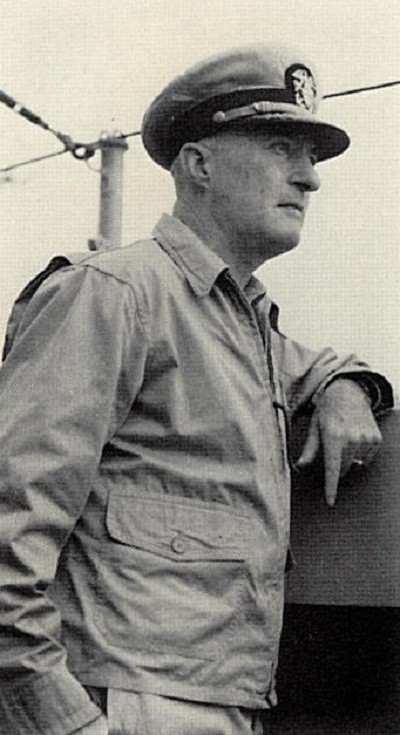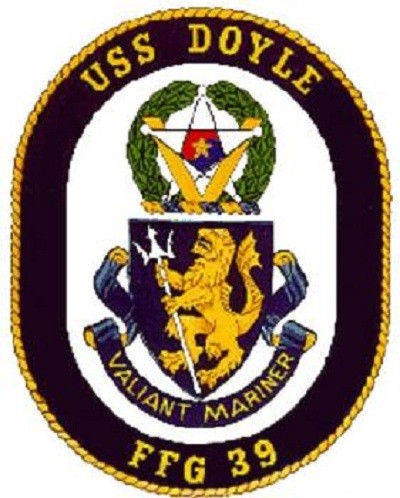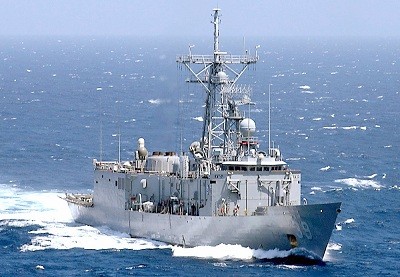Doyle II (FFG-39)
1983-2011
The first Doyle, a destroyer (DD-494) was reclassified to a destroyer minesweeper (DMS-34) on 23 June 1945, served from 1943-1955, and was named for Richard Doyle, who entered the Navy on board schooner Enterprise at Malta on 25 August 1803. Promoted to the rate of quarter gunner on 14 November 1803, he volunteered for the expedition under Lieutenant Stephen Decatur, Jr., that entered the harbor of Tripoli and destroyed the former U.S. frigate Philadelphia on 16 February 1804. Doyle later served in frigate John Adams, and died on 27 June 1807 while serving in Wasp. For additional information see (http://www.history.navy.mil/research/histories/ship-histories/danfs/d/doyle.html).
II
The second Doyle (FFG-39) was named for James Henry Doyle, born on 29 August 1897 in Astoria, Long Island, New York, son of John J. and Elizabeth (Johnson) Doyle, graduated from the Jamaica Model School and Jamaica High School. Doyle briefly attempted a career in motion pictures, which the Naval Academy’s Lucky Bag 1920 yearbook succinctly summarized as “short, snappy, and even breezy.” Doyle entered the Naval Academy in 1916, and the midshipman’s Fiji Island wit and mandolin enhanced his popularity with his classmates during his Plebe (fourth or entering class) year. Doyle sailed on summer midshipmen cruises on board Arkansas (Battleship No. 33) and Connecticut (Battleship No. 18), successively. He graduated and was commissioned an ensign on 6 June 1919.
Doyle served consecutively on board transport Mercury (ex-Barbarossa) (Id. No. 3012), battleship Pennsylvania (BB-38), destroyer George E. Badger (DD-196), battleship Delaware (BB-28), and submarine tender Camden (AS-6) (through 31 July 1926). He reported for duty in the office of the Judge Advocate General (JAG) of the Navy, Washington, D.C. (1 August 1926), and while so attached attended the George Washington University Law School, graduating with distinction in 1929.
He returned to sea and joined destroyer Lawrence (DD-250) as her executive officer (July 1929–August 1930), and then served in a similar capacity on board destroyer Buchanan (DD-131). He was detached (June 1932) and served in the office of JAG, after which he was aide and flag secretary on the staff of Commander Destroyers, Battle Force, on board light cruiser Detroit (CL-8) (June 1935–June 1937). Doyle commanded destroyer Sands (DD-243) until she was (temporarily) decommissioned (15 September 1938). For the next two years he served as aide to the Commandant, Sixteenth Naval District and the Cavite Navy Yard, Philippine Islands.
Doyle commanded Destroyer Division 67 in the Atlantic, with additional duty at times in command of destroyer Herndon (DD-198) (through August 1940). The following month (9 September), he turned over the eight ships of the division to the British, under a destroyers-for-bases agreement, at Halifax, Nova Scotia, the first of six such transfers. The British subsequently renamed Herndon as Churchill (I.45). He commanded cargo ship Regulus (AK-14) (24 September 1940–May 1942).
He then had duty on the staff of Rear Adm. Richmond Kelly Turner, Commander Amphibious Force, South Pacific, and took part in Operation Watchtower: U.S. landings on Japanese-held Guadalcanal, Florida, Gavutu, Tanambogo, and Tulagi in the Solomon Islands (7 August 1942–15 July 1943). Doyle received the Legion of Merit for carrying out “his highly important tasks with utmost courage, perseverance and heroic devotion to duty, thereby contributing in large measure to the success of our forces in that strategic area,” in spite of numerous Japanese enemy air attacks and bombardments by shore batteries.
Doyle then served in the headquarters of Adm. Ernest J. King, Commander in Chief United States Fleet (November 1943–April 1945). After brief duty with Commander Cruisers, Pacific Fleet, he assumed command of light cruiser Pasadena (CL-65) the following month. Doyle subsequently received the Bronze Star (2 June–1 September 1945) for “Exercising ability and initiative, (he) skillfully directed his vessel in three anti-shipping sweeps and one shore bombardment in Japanese Empire home waters, in addition to outstanding service as a unit of the support force of the SECOND Carrier Task Force. Later, during the initial entry and occupation phases at Sagami Wan, (he) ably conducted his vessel as Flagship for the Commander of the Support Force…”
He was detached from his command of Pasadena (May 1946) and became a member of the UN’s Military Staff Committee of the Security Council in New York (until September 1947), before serving as Inspector-Instructor of Naval Reserves, Thirteenth Naval District, Seattle, Wash. Ordered (January 1948) to the Amphibious Training Command, Pacific Fleet, at Coronado, Calif., he led that command (26 March 1948–January 1950) until he reported as Commander Amphibious Group 1, with additional duty as Command Transport Squadron 1.
Despite warnings from multiple Western intelligence sources, the North Koreans began the Korean War by achieving tactical surprise and invading South Korea (25 June 1950). The U.S. asked for an emergency meeting of the UN Security Council and the council adopted a resolution condemning the North Korean aggression, ordered the withdrawal of North Korean troops above the 38th parallel, and called on all members to assist the UN in the execution of the resolution. The Soviets had boycotted the council in protest of ongoing American support of the Chinese Nationalists, and their absence prevented their veto of the motion, enabling the UN to aid the South Koreans. Despite this assistance, the invaders overran much of South Korea.
Commander U.S. Far East Command and UN troops in Korea Gen. Douglas A. MacArthur, USA, surmised that a successful landing in the Inchon area of South Korea, and the rapid seizure of the nearby airfield at Kimpo, would enable the allies to liberate the South Korean capital of Seoul, turn the flank of the North Koreans, and cut their rail and road supply routes into the south. Escort aircraft carriers Badoeng Strait (CVE-116) and Sicily (CVE-118) launched preliminary strikes against North Korean troops around Inchon and on roads leading into Seoul (14 September 1950).
The following day, Doyle led Task Force (TF) 90 through a narrow channel impeded by mud banks and islands that restricted the long approach and landed the First Marine Division at Inchon. Planes, jets, and naval gunfire supported the leading Marines as they seized fortified Wolmi Island. The landing craft regrouped and incurred a delay of about 12 hours to ensure that the treacherous tide again became favorable, and the Marines followed up with an assault of the mainland at Inchon. “The Navy and the Marines,” MacArthur wrote Vice Adm. Arthur D. Struble, Commander Seventh Fleet, “have never shone more brightly than this morning.” Through 3 October carrier aircraft flew close air support missions and strikes against enemy lines of communication to support the advance inland. The success of the landings changed the course of the war. Doyle later received the Army’s Silver Star for his “…conspicuous gallantry in action in the Inchon-Seoul operation during the period September 15 to September 21, 1950. His actions contributed materially to the success of this operation...”

While UN troops approached the Chinese and North Korean borders along the Yalu River, communist leaders from Moscow to Peking (Beijing) argued that the allied advance comprised part of a global U.S. conspiracy to encircle the East Bloc. Chinese Premier Mao Tse-tung [Zedong] stated his expectation of American attacks across the Formosa (Taiwan) Strait, the Philippines, and French Indochina, and pledged to support the foundering North Korean regime. Chinese soldiers from 12 divisions began to cross the Yalu from Manchuria (19 October), and several days later clashed with American and South Korean troops before deceptively withdrawing. As enemy opposition thus stiffened the U.S. fast carriers returned to attack targets in their assigned area east of the 127th meridian (6 November). Two days later, these carriers received the primary mission of cutting off Chinese Communist reinforcements from Manchuria by destroying the international bridges across the Yalu. Political considerations restricted UN aircraft from pursuing communist aircraft across the river into Chinese territory to avoid escalating the war to embroil the Soviets. These restrictions frustrated the allies and allowed enemy aircraft to escape retribution in what became a safe haven
The failure to drop the bridges over the Yalu River, North Korea, enabled the Chinese Communist Ninth and Thirteenth Army Groups, comprising 26 divisions numbering 260,000 men, to launch a second offensive to close the jaws of a giant trap (27 November 1950). “We face an entirely new war,” MacArthur declared.
Within days of their offensive the Chinese tore gaps in the allied lines. The Communists smashed through the South Korean troops and then attacked the exposed flanks of the U.S. soldiers and Marines, especially in the rugged mountains northwest of Chosin Reservoir. Their drive sent the UN troops (the U.S. commands principally comprised the First Marine Division and the Army’s Third and Seventh Infantry Divisions) into a retreat through the onset of winter. Doyle hurriedly sailed the ships of TF 90 to Hŭngnam, North Korea, and rescued 105,000 American and South Korean troops and 91,000 civilians who fled the pursing Communists (10–24 December), an operation, ironically, in which the first ship named Doyle (DMS-34) participated, sweeping a special fire-support area to cover the emergency evacuation. The vessels also loaded 350,000 tons of supplies. Allied aircraft and naval gunfire covered the withdrawal and delayed the onslaught of Chinese and North Korean columns. Following the evacuation of the last survivors, troops destroyed the harbor facilities with demolition charges to prevent their use by the enemy. The enemy advance then rolled past the 38th parallel, and Doyle continued to evacuate troops and civilian refugees by ships into the New Year.
Doyle later received the Distinguished Service Medal for his part in the “…operations against enemy forces in the Korea area from June 25, 1950 to January 1, 1951. Directing the maneuvers of his various units with exceptional skill and foresight he was personally responsible for the success of the administrative landing of the FIRST Cavalry Division at Pohang-Dong, and for the planning and execution of the amphibious phases of the assault on Inchon and landings at Wonsan. Later, in the redeployment of friendly forces from Hungnam to Pusan, Rear Admiral Doyle, by his wise leadership, tireless efforts and profound knowledge of amphibious warfare, furnished the guidance for a unique and completely successful evacuation…”
Doyle reported for duty as President of the Navy Board of Inspection and Survey (September 1951–May 1952). He then served as Chairman of the Joint Amphibious Board at Little Creek, Va., until he retired (1 November 1953), and was simultaneously advanced to the rank of vice adm., on the basis of his combat awards. During the admiral’s retirement from active service, he continued his law practice in the District of Columbia, as well as before the Supreme Court and Court of Appeals of the District. He and his wife, Eleanor R. [Fields] of Brookline, Mass., had two sons: James H., Jr., who graduated from the Naval Academy, Class of 1947, saw service in China and the Vietnam War, received the Distinguished Service Medal and the Bronze Star, and retired as a rear admiral; and John J. Vice Adm. Doyle died of coronary and respiratory ailments at Oakland, Calif., on 9 February 1981.
(FFG-39: displacement 4,050; length 453'; beam 47'; draft 26'; speed 29+ knots; complement 217; armament RIM-156 SM-1MR Standard surface-to-air missiles, RGM-84 Harpoon surface-to-surface missiles, 1 76 millimeter rapid fire gun, 1 Mk 15 Close In Weapon System (CIWS), 6 Mk 46 torpedoes, and 4 .50-caliber machine guns; aircraft 2 Sikorsky SH-60B Light Airborne Multi-Purpose System (LAMPS) III Seahawks; class Oliver Hazard Perry)
The second Doyle (FFG-39) was laid down on 23 October 1981 at Bath, Maine., by Bath Iron Works Corp.; launched on 22 May 1982; cosponsored by Mrs. Kathleen D. Watson and Ms. Ann J. Doyle, granddaughters of the late Vice Adm. Doyle; and commissioned on 21 May 1983, Cmdr. William J. Erickson in command.

The Shield
Dark blue and gold are the colors traditionally used by the Navy and represent the sea and excellence. The creature, half lion and half fish, with Neptune’s trident symbolizes Vice Admiral Doyle’s prowess and his accomplishments in amphibious operations.
The Crest
The stars, laurel wreath, and “Vee” refer to some of Doyle’s decorations and awards: the Distinguished Service Medal; Silver Star; Bronze Star; and Legion of Merit. The reference to the Korean Taeguk commemorates Doyle’s masterful exploits during the Korean War, especially the Inchon invasion and the Hŭngnam withdrawal.

While Doyle deployed with the Nimitz (CVN-68) Battle Group for Med 1-87 to the Sixth Fleet in the Mediterranean (30 December 1986–30 June 1987), she sailed in company with guided missile cruiser Josephus Daniels (CG-27) through the Turkish Straits and carried out freedom of navigation exercises in the Black Sea (24 February–3 March 1987). A Bulgarian Druzki (Riga) class frigate (FF.12) harassed the U.S. ships (1 March), and the Soviets also monitored the American ships’ intrusion into the Black Sea. Following Doyle’s voyage into the Black Sea, she conducted surveillance of Soviet ships and submarines at an anchorage at Astypalaia, Greece (3–12 March).
During a counter narcotics deployment to the Caribbean (4 April–20 June 2005), Doyle, and Cutlass 463, her embarked Sikorsky SH-60B Seahawk of Helicopter Antisubmarine Squadron (Light) (HSL) 46 Detachment 3, pursued fishing vessel Dos Continentes, suspected of smuggling cocaine, north of the Panamanian/Colombian coast (3 May). The smugglers set their boat ablaze and jumped overboard. Doyle launched Cutlass 463 and made for the scene at flank speed. She lowered a rigid hull inflatable boat (RHIB) that rescued four of the smugglers, and battled the fire for several hours until they extinguished the flames during the mid watch. The ship’s damage control sailors, reinforced by Coast Guard law enforcement agents, boarded Dos Continentes and recovered several packages containing 150 pounds of cocaine from the hulk. Doyle prevented an estimated 13 tons of cocaine from entering the United States during this interception, and the U.S. later sank the vessel to prevent her from becoming a hazard to navigation. The frigate made a total of five interdictions during her deployment that led to the apprehension of 28 narco-terrorists, and the seizure or destruction of an estimated $315 million worth of cocaine (83 bales during the first month alone).
Doyle, with Proud Warrior 423, her embarked SH-60B Seahawk from HSL-42, and her embarked Coast Guard Law Enforcement detachment (LEDET), intercepted smuggling vessel Rio Tuira and seized 22 bales of cocaine, weighing approximately 500 kilos (1,100 pounds) and with an estimated street value of $15.4 million, in the Eastern Pacific about 180 miles from Panama (6 December 2010).
Decommissioned at Mayport on 29 July 2011, Doyle lies moored, pending disposal, at the Naval Sea Systems Command (NavSea) Inactive Ships On-site Maintenance Office, Philadelphia, Pa.
Detailed history under construction.
Mark L. Evans


